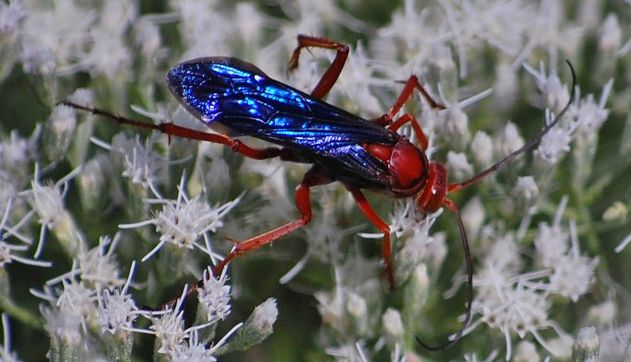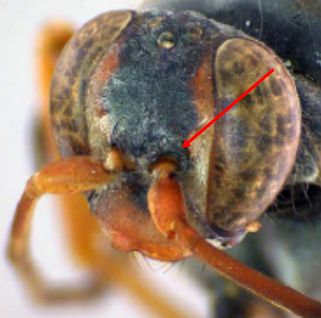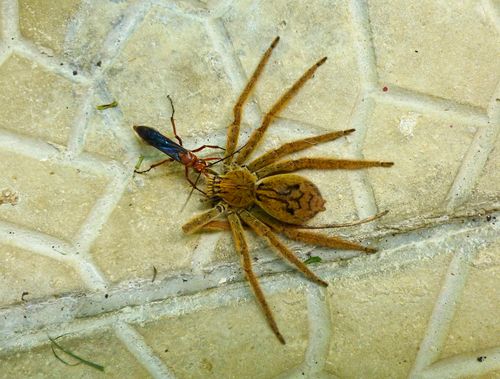The Featured Creatures collection provides in-depth profiles of insects, nematodes, arachnids and other organisms relevant to Florida. These profiles are intended for the use of interested laypersons with some knowledge of biology as well as academic audiences.
Introduction
The rusty spider wasp, Tachypompilus ferrugineus (Say), is a large, reddish orange wasp with conspicuous iridescent blue to violet wings (Figure 1). Aptly named, the rusty spider wasp specializes in hunting large spiders, which it paralyzes and provides for its offspring to consume. These eye-catching wasps can be seen scanning loose soil for spider burrows, nectaring at flowers, or dragging large spiders back to their nests (Figure 3).

Credit: Sheryl Pollock, discoverlife.org
Synonymy
The synonyms for Tachypompilus ferrugineus (Say) are as follows (Poole 1996).
Junior synonyms:
Pompilus torridus Smith (1862)
Arachnophroctonus annexus Banks (1944)
Arachnophroctonus nigrescens Banks (1944)
Tachypompilus yavapai Evans (1950)
Arachnophroctonus unicolor Banks (1944) is a junior homonym of the subspecies Tachypompilus ferregineus torridus (Smith), but the name was first used by Banks in 1919 to describe what is now classified as another species in the genus (Evans 1950).
Distribution
Tachypompilus ferrugineus has been widely collected in North America. It is more commonly encountered east of the Mississippi River than to the west (Wasbauer and Kimsey 1985). Additionally, the species occurs in Central America and the Caribbean, and has been collected in Costa Rica, Colombia, and the Dominican Republic (Ascher and Pickering 2018, Monteiro 2014). Males and females are active during the warmer months of the year and have been observed flying as early as mid-June and as late as the end of August (Kurczewski 1989, Ascher and Pickering 2018).
Description
Adults
It is easy to identify spider wasps in the genus Tachypompilus by their large size, ranging from 11Â to 25 mm in length, iridescent blue wings, and rust-colored body (Evans 1950). One character useful for distinguishing this genus from other spider wasps in the family Pompilidae include a distinctive blunt tubercle which arises slightly above the antennal base (Figure 2).

Credit: Cecilia W. Monteiro (Monteiro 2014)
Within the genus Tachypompilus, there is significant size variation ranging from 7 to 30 mm in length, and Tachypompilus ferrugineus is at the larger end of this spectrum with some females as large as 25 mm (Evans 1950). Females are distinguishable from males by their larger size and the presence of a visible ovipositor. Tachypompilus ferrugineus is distinguishable from the one other species in the genus (Tachypompilus unicolor) by the elongate third antennal segment which is 1.3 to 1.8 times the length of the distance between the tops of the eyes (Kurczewski 1989).
Eggs, Larvae, and Pupae
The eggs of Tachypompilus ferrugineus are 0.3 to 0.4 cm in length. The female attaches one egg to a paralyzed host spider that she has dragged back to her burrow (Kurczewski 1989). No observations of the larvae or pupae of any Tachypomilus wasp have been recorded in the literature. Tachypomilus wasps are expected to follow the same developmental pattern of other spider wasps and mature through five larval instars and a pupal stage before eclosing as adults and emerging from their burrows.
Nests
Nest type and construction is species-specific in these wasps. Solitary female Tachypompilus ferrugineus dig simple nests in soil that are either concave or somewhat conical in shape and 2 to 2.5 cm deep and 3.5 to 4.5 cm in diameter (Kurczewski 1989). In each nest, the female wasp places one paralyzed spider to which she attaches one egg. It is not known how many of these single-egg nests one female will construct. After attaching the egg, she fills in the nest with soil using her forelegs and mandibles and then taps it down by rapidly beating her abdomen on the soil (Standtmann 1953). Due to the vulnerable nature of these shallow nests, females typically construct them under buildings, vegetation, large debris, or other protective structures (Standtmann 1953, Kurczewski 2010). Tachypompilus ferrugineus has been observed to nest gregariously, and that these nesting aggregations can be persistent from year to year (Kurczewski 1989, Kurczewski 1990).
Behavior
The rusty spider wasp undergoes complete metamorphosis; however, the full life cycle for Tachypompilus ferrugineus is not well documented, most likely due to their solitary behavior and tendency to nest in difficult-to-reach places. Tachypompilus ferrugineus individuals begin as eggs that hatch into predacious larvae and consume the paralyzed host provisioned for them by their mother. After larval growth is complete, the wasps enter a pupal stage associated with very low metabolic activity and transformation in body form. When the pupal stage is complete the adult wasps eclose from their pupal casings and emerge from their shallow burrows. As adults, behaviors associated with mating, hunting, nesting, and egg laying have all been directly observed.
Mating
Male rusty spider wasps aggregate and perch near female nesting sites to wait for receptive females. Unlike other social wasp species, males are apparently not territorial, and there is no hierarchical system for mating based on size (Kurczewski 1990). Males approach females either head on or from the side as they land near their nests, then rapidly fan their wings and wave their antennae.
It is speculated that this may produce a sound to which females are receptive. Unmated females will respond to the behavior of the males by fanning their wings and waving their antennae (Kurczewski 1989). After a female gives this signal, the male flies to her posterior end and assumes a forward-facing copulation position very far back on her abdomen. Already-nesting females will not reciprocate the fanning and waving behavior and will fly away. These females will sometimes be followed by persistent, wing-fanning males (Kurczewski 1990). After copulation, females begin nest and provisioning.
Hunting
Tachypompilus ferrugineus females sting their spider prey into paralysis and then walk backwards to their nest, dragging the incapacitated spider with their mandibles (Figure 3). Often these spiders are much larger than the wasps, so the journey back to the nest can be very time consuming and apparently difficult (Kurczewski 1981). These laborious and conspicuous return trips to the nest have often been observed by people, and it is possible to find a spider wasp nest by simply following the wasp as it slowly drags its large prey.

Credit: Steven Easley, inaturalist.org
Nesting and Egg Laying
Upon returning to her nest, a Tachypompilus ferrugineus female grooms her nest further by patting the soil with her abdomen before placing the spider in the nest dorsal side up. Once ready to lay her egg, the female grasps the spider and flips it on top of her (Figure 4). In this position, the female probes the host with her ovipositor to select an attachment site and then deposits one egg and covers it with soil (Standtmann 1953).

Credit: Illustration presented by R. W. Strandtmann (Standtmann 1953)
Hosts
Animal Hosts
Like other spider wasps in the family Pompilidae, the rusty spider wasp preys on spiders. Specifically, it specializes on spiders in the family Lycosidae, commonly referred to as wolf spiders. Tachypompilus species have also been observed collecting the closely related spider families Pisauridae and Agelenidae, commonly known as nursery spiders and grass or funnel spiders (Kurczewski and Kurczewski 1968). The central challenge with these hosts is that they are very large relative to the wasp. Studies have reported wasps collecting host spiders up to five times larger by mass than the wasps (Kurczewski and Kurczewski 1968; Kurczewski 1981).
Plant Hosts
Tachypompilus ferrugineus consume most of their nutrients as growing immatures, and the source of this nutrition is the host spider. However, adult wasps will take nectar from plants as a source of secondary carbohydrates. Tachypompilus ferrugineus males have been observed taking nectar from wild carrot or Queen Anne's lace (Daucus carota) (Kurczewski 1989; Kurczewski 1990).
Importance
Tachypompilus ferrugineus is not considered to be a pest, nor is it considered to be particularly dangerous to humans. Although the rusty spider wasp is quite large and can look somewhat threatening, it is not known to be aggressive toward animals other than its prey, unlike more commonly observed social wasps. Like many solitary wasps, Tachypompilus ferrugineus is primarily concerned with mating, nesting, and hunting, and it has rarely been reported in areas heavily populated by humans (Ascher and Pickering 2018). The likelihood of being stung by Tachypompilus ferrugineus is very low, and there is no need to manage the species.
Selected References
Ascher JS, Pickering J. 2018. Discover Life bee species guide and world checklist (Hymenoptera: Apoidea: Anthophila). (14 October 2018). https://www.discoverlife.org.
Evans HE. 1950. "A taxonomic study of the Nearctic spider wasps belonging to the tribe Pompilini (Hymenoptera: Pompilidae)." Part I. Transaction of the American Entomological Society 75: 133–270.
Kurczewski FE. 1981. "Observations on the nesting behaviors of spider-wasps in southern Florida (Hymenoptera: Pompilidae)." Florida Entomologist 64: 424–437.
Kurczewski FE. 1989. "Ecology, mating and nesting of Tachypompilus ferrugineus nigrescens(Hymenoptera: Pompilidae)." Great Lakes Entomology 22: 75–77.
Kurczewski FE. 1990. "Additional observations on Tachypompilus ferrugineus with emphasis on male behavior (Hymenoptera: Pompilidae)." Great Lakes Entomology 23: 159–163.
Kurczewski FE, Kurczewski EJ. 1968. "Host records for some North American Pompilidae (Hymenoptera) with a discussion of factors in prey selection." Journal of the Kansas Entomological Society 44: 1–33.
Monteiro CW. 2014. Systematics and behavioral evolution of spider wasps (Hymenoptera: Pompilidae). Doctoral dissertation. Utah State University. Retrieved from ProQuest. UMI: 3683614. p. 120.
Poole RW. 1996. Nomina Insecta Nearctica: A Check List of the Insects of North America. Volume II. Entomological Information Services. p. 295.
Standtmann RW. 1953. "Notes on the nesting habits of some digger wasps." Journal of the Kansas Entomological Society 26: 45–52.
Wasbauer MS, Kimsey LS. 1985. "California spider wasps of the subfamily Pompilinae (Hymenoptera: Pompilidae)." Bulletin of the California Insect Survey 26: 37–39.